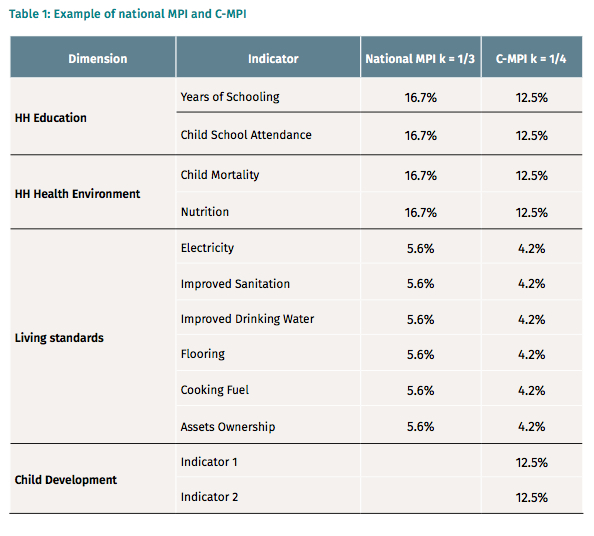
Search
Building a Child Poverty Measure to Inform Policy

Children are especially vulnerable to poverty. Child poverty tends to be higher than poverty among adults, and the experience of poverty during childhood can have negative lasting effects on individuals’ lives. The 2030 Agenda, in particular target 1.2 of the Sustainable Development Goals (SDGs), requires information on multidimensional poverty among children. Most commonly, this information will be obtained by disaggregating the national Multidimensional Poverty Index (MPI) by age to illuminate child poverty. It could however also draw on a stand-alone measure of child poverty*.
Tracking child poverty based on national measures
Many countries are already tracking multidimensional poverty using national MPIs. These national indices define poverty status based on a set of indicators, typically including some related to children’s achievements (e.g. household is deprived in school attendance if there is at least one school-age child who is not attending school) and others capturing household features that affect children’s life chances (e.g. adequate sanitation and safe water). Child poverty can be measured by disaggregating the national MPI by age groups, which implies identifying as poor those children who live in poor households. To date, this disaggregation has proved very powerful. It shows that often poverty is higher among children than among other groups. It also shows how children are poor by revealing the different composition of deprivations they tend to experience.
These national measures might, in some cases, be enriched to provide a stronger diagnostic and policy tool to fight children’s individual deprivations. The process of enriching such poverty measures consists of expanding the indicators based on children’s achievements, for example beyond nutrition and school attendance to include child labour, early marriage and immunisation. Furthermore, the micro-data used to estimate the national MPI can also be used to analyse the intra-household patterns of child deprivations that are reflected in the national MPI.
Methodologies to measure child poverty
Another possible approach to capture child poverty is to build a stand-alone child poverty measure, which can reveal deprivations that strike siblings of different ages or genders differently within the same household. In the literature, there are some examples of methodologies to measure child poverty. The most prominent are the “Bristol approach” and the Multiple Overlapping Deprivation Analysis (MODA). Both methods define child poverty as the sum of unmet child rights. On the one hand, the anchoring of the measures’ parameters on internationally agreed standards, like the Convention on the Rights of the Child, makes them easy to justify and, hence, especially attractive for advocacy purposes. On the other hand, some axiomatic requirements of these methodologies might hinder their usefulness in informing policy making.
The 2030 Agenda, in particular target 1.2 of the Sustainable Development Goals (SDGs), requires information on multidimensional poverty among children.
One requirement that might be particularly problematic is the aggregation of indicators into dimensional sub-indices using the ‘union approach’. In this step, used in MODA, a child is identified as deprived in a dimensional sub-index if she/he is deprived in at least one of the indicators in that dimension. The disadvantage of the MODA approach is that, when breaking down the index by dimension to see the composition of poverty, it is not possible to see which of the indicators combined in that dimension is driving the level of deprivation. This loss of information makes it difficult to identify the appropriate policy responses and to track progress. For example, suppose a measure where a child is deprived in the right to health if she is not immunised, or if there was no skilled birth attendant at her birth. In these circumstances, policy makers face a high level of deprivation in health but will not know if they should design interventions aimed at increasing immunisation or improving access to skilled birth attendance or both.
Another rigid requirement is equal weights across dimensions/rights and zero weights for non-rights. While, equal weights across rights is a useful normative tool, the grouping and identification of indicators into child rights is itself the subject of ongoing discussion at the national level and the combination of this requirement with union-based dimensional sub-indices may give odd results. For example, the requirement of equal weights might lead to situations where two deprivations with disparate levels of impact on children‘s well-being have equal importance in identifying a child as poor. In some MODA applications, “ownership of an information device”, the indicator that captures access to information, is considered as important as school attendance and education attainment, the indicators that capture right to education. In these circumstances, if 10% of children are out of school (only) and 10% lack a cell phone (only), it will be far cheaper to hand out cell phones than put 10% of children into school and both would have the same impact on measured poverty. In addition, this weighting requirement can be used to exclude indicators such as child labour, which might be seen as relevant to measure child poverty, but do not correspond to a child right.
National MPI plus a ‘linked’ C-MPI
The Alkire-Foster method, which underlies all existing official national multidimensional poverty measures, can be used to build child-specific measures of poverty.
Grounding the national and child-specific poverty measures on the Alkire-Foster method makes them easier to build because the same experts can confidently design both –and interpret– because stakeholders have become familiar with the MPI method. However, having two separate measures, with different indicators, creates challenges in communication and policy applications. For example, both measures might include water and sanitation, but grouped into different dimensions and with different associated policy recommendations. Which one is the country to use? Also, it might be difficult for the Minister of Planning to memorize and rattle off the 4 dimensions and 14 indicators of the national MPI and the 7 dimensions and 12 indicators of the child MPI to a journalist who wants to write about poverty.
To minimize confusion and maximize the potential contribution of the MPI to policy, the national and child MPIs should be linked. In particular, we propose that countries build a ‘linked’ C-MPI by extending the national MPI to include child specific deprivations. This ‘linked’ C-MPI, defined at the child level, includes the exact same dimensions and indicators as the national MPI, plus a child dimension. The new child dimension has age-specific indicators that trace each child’s individual deprivations. The household-level indicators, from the national MPI, capture children’s deprivations associated with their context, while the individual level indicators, in the child dimension, directly capture the child’s individual situation.
When this linked and streamlined measurement strategy is followed, the identification of poor children builds on the identification used in the national measure. In other words, the ‘linked’ C-MPI inherently identifies as poor the children living in poor households – the same children that would be identified as poor when disaggregating the national measure by age groups. In addition, the ‘linked’ C-MPI brings into view children with high levels of deprivations who are living in non-poor households and, hence, are non-poor based on the national metric alone.
To obtain this intuitive result, the weights of the indicators and the poverty cut-off of the ‘linked’ C-MPI are set in a way that means children living in poor households are identified as poor. Table 1 presents an example of the structure of a national MPI, side by side with a ‘linked’ C-MPI. The national MPI includes 10 indicators and identifies as poor those who are deprived in at least one-third of the weighted indicators. The ‘linked’ C-MPI adds a fourth dimension – two child-specific indicators. The weights of the ‘linked’ C-MPI indicators and the poverty cut-off of one fourth ensure that those children who are deprived in at least one-third of the household level indicators, which corresponds to a fourth of the C-MPI weighted indicators, are identified as poor. Additionally, this weighting structure and poverty cut-off ensure that the children who are deprived in both child-specific indicators but in none of the household level indicators are also identified as poor, as are children deprived in one child-specific indicator plus a smaller group of household indicators.
Having a child-specific measure, in addition to a national multidimensional poverty measure, enables governments to focus on the particular situation of children. The analysis of a C-MPI ‘linked’ to a national MPI provides valuable information to inform policy making. First, it identifies poor children living in non-MPI poor households, as well as additional child deprivations carried by children living in MPI poor households. Second, it shines a light on the intra-household situation, showing whether all children are poor within a household or just a few. Third, it shows how child poverty varies according to the age and gender of the child.
Yet it does so in a compact easy-to-communicate form, which builds on and deepens analysis of a National MPI, and creates integrated and synergistic policy messaging.
* This article is based on OPHI Working Paper 127 “The State of Multidimensional Child Poverty in South Asia: A Contextual and Gendered View”.
This article was published in Dimensions 7.

















